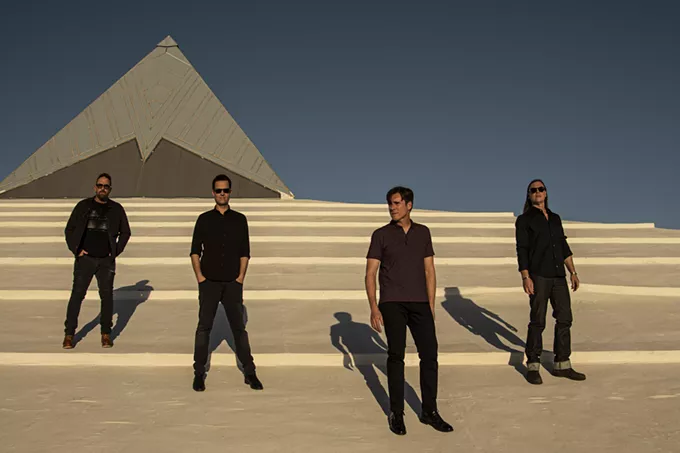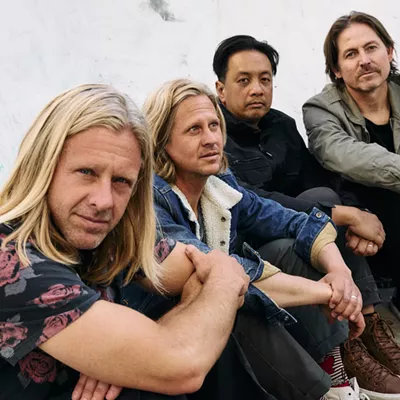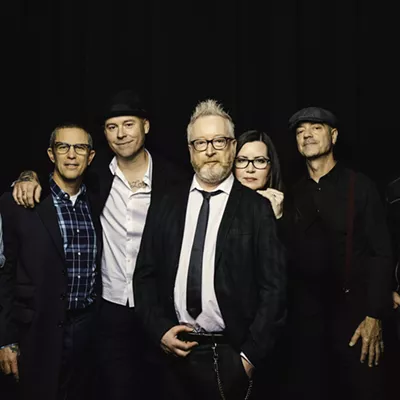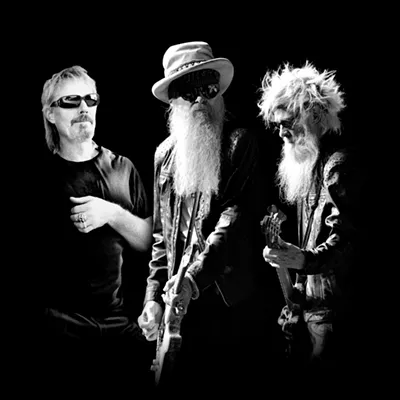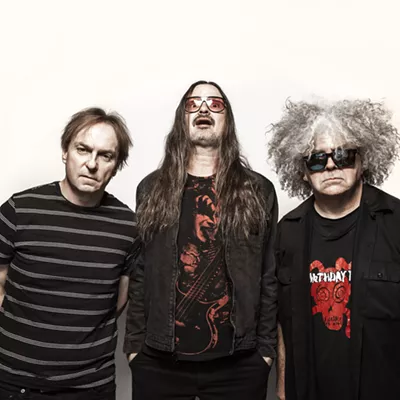Going by singles and album charts and sales, it’s easy to assume that the high point in the career of Jimmy Eat World came with the band’s third album, 2001’s “Bleed American,” and its hit single, “The Middle.”
But singer/guitarist Jim Adkins notes that album sales and chart positions don’t tell the whole story of a band’s career journey. At least that’s the case for Jimmy Eat World, as the band has hit the 30-year mark since Adkins, guitarist Tom Linton, bassist Rick Burch and drummer Zach Lind formed the band in Mesa.
“‘Bleed American’ gave us a start. It definitely changed things for us,” Adkins observed in a recent phone interview. “But we’re playing bigger shows now to more people than we ever have. Like we’re playing at Red Rocks. We’re playing Central Park. We’re playing at the Greek (in Los Angeles). We couldn’t do any of those, even at the time when ‘The Middle’ was like the top song in the country and we were on ‘Saturday Night Live.’ It’s just started something for us that we’ve been fortunate enough to sort of nurture along and then build from there. It definitely gave us a big jump. It was the nitro for our race car. Now we’re just cruising along.”
This spring sees Jimmy Eat World performing “Futures,” the 2004 album that followed “Bleed American,” in its entirety on a tour that includes dates at Tucson’s Rialto Theatre, and for the first time, the Van Buren in Phoenix.
Beyond material from “Futures” and “Bleed American,” Adkins and his bandmates have plenty of song choices at this point.
Their catalog includes 10 studio albums, the most recent of which was 2019’s “Surviving.” But the band has since released a trio of stand-alone singles, “Something Loud,” “Telepath” and “Place Your Debts,” the latter of which reached No. 21 on Billboard magazine’s Alternative Airplay chart.
“We put out the singles because we’d never done that before and we wanted to see if we could meet listeners where they’re at when it seems like so much is consumed (track) by track instead of by album, on playlists rather than full-lengths,” Adkins said.
“It really just comes down to what do you want to do as an art-producing entity and what’s best for you,” he added. “There are a lot of things to consider, but the landscape is the wild west. Whatever you want to do, you certainly can. And nobody knows what the magic formula is for something that is going to break through. It is solely on you to decide what you want. I think if you’re chasing an idea of something you think is going to break through, that’s going to turn people off. And there’s no guarantee that’s going to succeed, even if you nail it. I think you’re much better off chasing the ideas you’re excited about, and if that ends up being like this conceptual three-year plan with like double albums every year, or if it’s just like I really love this song. I can’t wait to get it out. I am uploading it right now, it’s cool. I think people will resonate with the honesty behind that.”
There have certainly been times when Jimmy Eat World’s albums have connected as well. That’s especially true of “Bleed American,” which became a platinum-selling hit and gave the band its first No. 1 single, “The Middle,” which topped “Billboard’s” Alternative Airplay chart and peaked at No. 5 on the magazine’s all-genre Hot 100 singles chart. “Futures,” gave the band another Alternative Airplay chart topper with the song “Pain.” Subsequent albums, if not as popular, have generally peaked in the top 20 of the “Billboard” chart and several later singles have been top 10 Alternative Airplay hits.
“Bleed American” and “Futures,” along with the band’s third album, 1999’s “Clarity,” earned Jimmy Eat World recognition as one of the founding fathers of the musical genre known as emo. Although the band members never fully embraced that label, they have come to terms with their relationship to it.
Adkins acknowledges that there have been benefits to being labeled emo, even though he has never felt it accurately described Jimmy Eat World’s catchy and rocking style of guitar pop.
“It’s a mixed bag, for sure,” Adkins said of the emo label. “I think people want to categorize bands in music, and if you don’t have any category, it’s a little tougher for the elevator pitch, why your friends should check out this thing that you like. So I think in that regard, it’s helped because it’s been like a shorthand to describe a scene that we sort of came up in, I guess. As far as helping you out musically with what that might actually sound like, it’s not very helpful. But for better or worse, it describes the period of time and the scene we were involved with.
“It is a little bit of a head scratcher because it’s not like, if you think about literally what it means in art in general, I mean, the word can be any word. Like grunge, you know, it sort of described, it didn’t exactly describe a complete aesthetic perfectly. It just was a word that got attached to a specific scene and a specific time,” he elaborated. “It would be like if I said hardcore or if I said punk, you’d have a roomful of different answers when you ask the question to a room what those are. And even with something like emo, you are going to get a lot of different answers. Some people are going to say Rites of Spring, some people are going to say Fall Out Boy, some people are going to say My Chemical Romance. Some people are going to say Converge. It’s going to be all over the place.”
Despite it being two decades or so since emo peaked as a “thing” within the overall rock music scene Adkins has accepted the idea that Jimmy Eat World will always be considered emo.
“I don’t think we can escape it now. We crossed the event horizon some time ago,” he said. “Now it’s just like I could try to argue with people why where I grew up and what scene I came up in exactly, why I feel like that describes something other than what we do. But it’s just wasted breath. At this point, if somebody finds something we do that they can connect with, however that comes to be, is a huge compliment. It’s the only validation that really matters in music and art. So if that comes with emo being a part of that whole equation, then I am grateful.”
Jimmy Eat World
WHEN: 8 p.m. Friday, April 18
WHERE: Rialto Theatre, 318 E. Congress Street, Tucson
COST: Tickets start at $49.50
INFO: rialtotheatre.com

